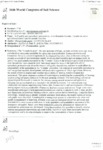Por favor, use este identificador para citar o enlazar este ítem:
http://www.alice.cnptia.embrapa.br/alice/handle/doc/482346Registro completo de metadatos
| Campo DC | Valor | Lengua/Idioma |
|---|---|---|
| dc.contributor.author | SANTANA, D. P. | pt_BR |
| dc.contributor.author | BAHIA FILHO, A. F. C. | pt_BR |
| dc.date.accessioned | 2011-04-10T11:11:11Z | pt_BR |
| dc.date.accessioned | 2011-04-10T11:11:11Z | pt_BR |
| dc.date.available | 2011-04-10T11:11:11Z | pt_BR |
| dc.date.available | 2011-04-10T11:11:11Z | pt_BR |
| dc.date.created | 1999-05-18 | pt_BR |
| dc.date.issued | 1998 | pt_BR |
| dc.identifier.citation | In: WORLD CONGRESS OF SOIL SCIENCE, 16., 1998, Montpellier. Proceedings. Montpellier: CIRAD, 1998. | pt_BR |
| dc.identifier.uri | http://www.alice.cnptia.embrapa.br/alice/handle/doc/482346 | pt_BR |
| dc.description | The "Cerrado Region" - the acid savannas of Brazil, as many as thirty years ago, were considered as ecosystem unsuitable for agriculture crop production because environmental limitations. However, a burst in agricultural development has taken place in the area during last decades as a result of new technology mainly involving plant breeding and soil management. In spite of the great contribution made by the "Cerrado" region to the Brazilian agricultural production, over the past few years concerns have been raised about the issue of the high costs of this agriculture production and about the issue of soil quality degradation, and how it could affect the sustainability of the agriculture in the "Cerrado" ecosystem. The concept of sustainable agriculture is well recognized research, development, and productive segments of today's agriculture, however, the notion of how to measure and monitor sustainability of farming systems is much les understood. This paper proposes a system of measuring and monitoring the sustainability of farming systems using soil quality indicators in the acid savannas of Brazil. The methodology utilized and agroecological framework to examine the relations among natural resources and agriculture, selectiong one agroecological zone inserted in the cerrado ecosystem. This selected zone was subdivided into regions superimposing Census data, because policy and socioeconomic differences among regions have a considerable influence on land-use systems and options. Target areas were selected and participatory rural appraisal procedure was used to supplement voids in data, identify and characterize predominant farming systems, and to capture farmer knowledge. Using this farmer knowledge, research results already available and local observations, the mainly factors affecting soil quality were identified. Assuming that a management system is sustainable only when soil quality is maintained of improved, physical, chemical and biological properties, processes and characteristics were closen as indicators to make qualitative and quantitative assessment of the changes in soil quality. Based upon these evaluations, a general procedure or framework for sustainability assessment was developed. Using the procedure, it is possible to identify whether current management interventions are contributing towards or away from sustainable farming management, and to develop strategies to improve sustainability of those systems. | pt_BR |
| dc.format | 1 CD-ROM. | pt_BR |
| dc.language.iso | eng | eng |
| dc.rights | openAccess | eng |
| dc.subject | Brasil | pt_BR |
| dc.subject | Savanna | pt_BR |
| dc.subject | Agricultural sustainability | pt_BR |
| dc.title | Soil quality and agricultural sustainability in the Brazilian Cerrado. | pt_BR |
| dc.type | Artigo em anais e proceedings | pt_BR |
| dc.date.updated | 2018-06-11T11:11:11Z | pt_BR |
| dc.subject.thesagro | Agricultura Sustentável | pt_BR |
| dc.subject.thesagro | Cerrado | pt_BR |
| dc.subject.thesagro | Solo | pt_BR |
| dc.subject.nalthesaurus | Brazil | pt_BR |
| dc.subject.nalthesaurus | soil | pt_BR |
| riaa.ainfo.id | 482346 | pt_BR |
| riaa.ainfo.lastupdate | 2018-06-11 -03:00:00 | pt_BR |
| dc.contributor.institution | DERLI PRUDENTE SANTANA, CNPMS. | pt_BR |
| Aparece en las colecciones: | Artigo em anais de congresso (CNPMS)  | |
Ficheros en este ítem:
| Fichero | Descripción | Tamaño | Formato | |
|---|---|---|---|---|
| Soilquality.pdf | 6.21 MB | Adobe PDF |  Visualizar/Abrir |









